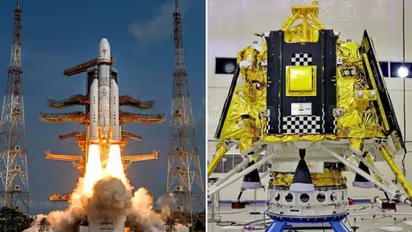Chandrayaan-3: How ISRO decided on launch window of 2:35 pm

Synopsis
Indian Space Research Organization has carefully determined the launch window of Chandrayaan-3 mission, and the significance of the chosen date and time. Girish Linganna explains the mission's objectives, the planned landing on the Moon's south pole, and the scientific instruments carried by the lander and rover.
The Indian Space Research Organization (ISRO) is gearing up for the highly anticipated Chandrayaan-3 mission, aimed at placing a lander and rover near the south pole of the Moon. The success of this mission hinges not only on advanced technology and meticulous planning but also on the careful determination of the launch window -- a crucial period during which the spacecraft can embark on its celestial journey.
ISRO has scheduled the launch of Chandrayaan-3 for July 14, 2023, at 2:35 pm IST. This carefully calculated timing takes into account a multitude of factors, including the alignment of planetary positions and the desired trajectory for reaching the Moon's surface. The launch will take place at the Satish Dhawan Space Centre in Sriharikota, India, utilizing the GSLV Mark 3 heavy-lift launch vehicle.
If the launch takes place on July 14, the estimated timeframe for landing on the Moon would be around August 23-24, as confirmed by ISRO chief Somanath in Bengaluru. To optimize the mission's objectives, ISRO aims for the landing to occur during the first lunar day, which marks the period between New Moon and Moonrise. This lunar day lasts only several minutes, culminating just before the next lunar month begins.
The selection of the launch date and time is of paramount importance. ISRO has strategically chosen the alignment of the Moon and the planet, aiming for a picture-perfect moment to commence the mission. The synchronization of celestial bodies during the launch enhances the mission's efficiency and accuracy says Dr Srimathy Kesan Founder and CEO of Space Kidz
The lunar surface and environmental conditions during the first lunar day offer optimal working conditions for the lander and rover. If the calculated launch window does not align with these parameters, ISRO will wait for the next suitable opportunity, likely in September, to ensure the mission's success says, Kesan
Once the Chandrayaan-3 propulsion module reaches the Moon's vicinity, it will manoeuvre into a 100 km circular polar lunar orbit before separating from the lander. The lander, equipped with a suite of advanced sensors and landing systems, will make its descent to the lunar surface in the south polar region. The planned touchdown velocity aims for less than 2 m/s vertically and 0.5 m/s horizontally, ensuring a gentle and controlled landing.
During the mission, the propulsion module will remain in lunar orbit, serving as a communications relay satellite to enable seamless communication with Earth. Additionally, Chandrayaan-2, the predecessor to Chandrayaan-3, will act as a backup relay, ensuring uninterrupted contact with the lander and rover on the lunar surface.
The lander and rover, specifically designed for this mission, are engineered to operate for one lunar daylight period, equivalent to approximately 14 Earth days. They carry a suite of scientific instruments, including seismometers, spectrometers, and thermal measurement devices, to conduct comprehensive research and gather crucial data about the Moon's surface and environment.
With meticulous planning, advanced technology, and the precise determination of the launch window, Chandrayaan-3 aims to continue India's pursuit of lunar exploration and scientific discovery. As the nation eagerly awaits the historic launch, the success of this mission promises to propel India's space exploration endeavors to new heights, uncovering mysteries and enriching our understanding of Earth's celestial neighbour.
Find the latest Technology News covering Smartphone Updates, AI (Artificial Intelligence) breakthroughs, and innovations in space exploration. Stay updated on gadgets, apps, and digital trends with expert reviews, product comparisons, and tech insights. Download the Asianet News Official App from the Android Play Store and iPhone App Store for everything shaping the future of technology.